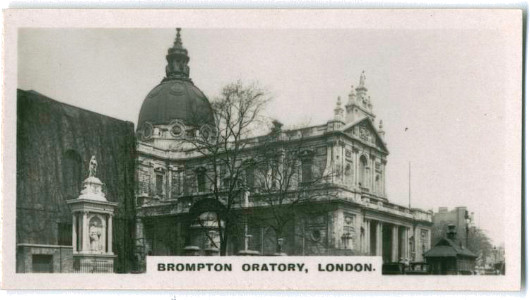Church
About Andrew Cusack
 Writer, web designer, etc.; born in New York; educated in Argentina, Scotland, and South Africa; now based in London.
Writer, web designer, etc.; born in New York; educated in Argentina, Scotland, and South Africa; now based in London. read more
News
Blogs
Reviews & Periodicals
Arts & Design
World
France
Mitteleuropa
Knickerbockers
Argentina
The Levant
Africa
Cape of Good Hope
Netherlands
Scandinavia
Québec
India
Muscovy
Germany
Academica
Notre Dame de Bon Secours, Pray for New Orleans!

Intercede for us with Jesus that we may always accept God’s graces and be found faithful to Him in our particular states of life. As you once saved our beloved City of New Orleans from ravaging flames, and our Country from an invading army, have pity on us and obtain for us protection from Hurricane Katrina and all other disasters.
Assist us in the many trials which beset our path through life. Watch over the Church and the Pope as they uphold with total fidelity the purity of faith and morals against unremitting opposition. Be to us truly Our Lady of Prompt Succor now and especially at the hour of our death, that we may gain everlasting life through the merits of Jesus Christ Who lives and reigns with the Father and the Holy Spirit, one God world without end.
Amen.
Rye Gothic
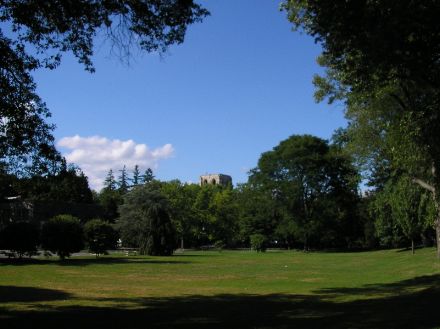
There’s a little portion of Rye on the Boston Post Road here in Westchester which is a veritable Gothic wonderland. From the south it begins on Rye High School’s beautiful campus with the track and playing field across a brook from the neo-Gothic middle and high school buildings, with sympathic additions covered in the same stone. Immediately to the north is the Victorian Gothic Rye Presbyterian Church, built in 1870 by architect Richard Upjohn, whose son and grandson designed two later additions, respectively. Just north of Rye Presbyterian is the Church of the Resurrection, and a little further north of that is Christ’s Church Rye, both of which are in the Gothic style.
The photo above shows the top of the crossing tower of the Church of the Resurrection, a 1930 structure built for Rye’s Catholic parish, viewed from Milton Road. I popped round to the area today and took a few photos, though I did not go inside Resurrection, as there was a wedding taking place. (more…)
The Church of St Agnes
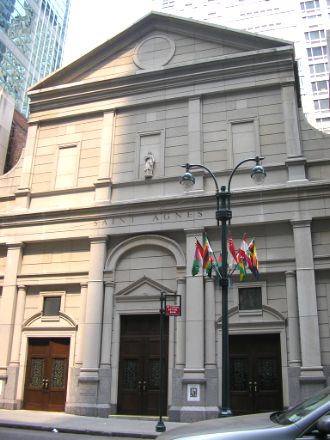
For those who have not seen St Agnes since it was rebuilt in a different style I thought I’d post a few photos I took after the 12:30 mass today. I don’t recall who the architect was; I believe it might be Thomas Gordon Smith. The reason for the vexilla-ed lampost is that East 43rd Street, in addition to being known as “Archbishop Fulton J. Sheen Place”, is also “U.N. Way” since the headquarters of that organisation terminates the vista eastwards. (more…)
Walsingham Tabernacle

I had not noticed that the tabernacle in the brand new Church of Our Lady of Walsingham in Houston, Texas was a smaller replica of the Ark of the Covenant.
Rather appropriate, considering one of Mary’s titles is ‘Ark of the New Covenant’.
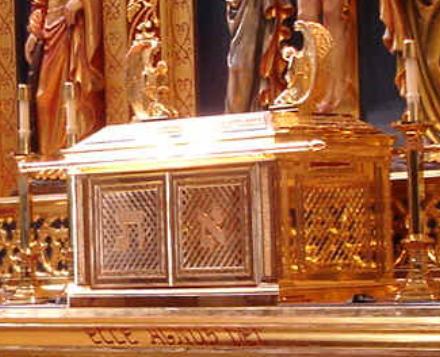
St. Edith Stein: Martyr for Truth
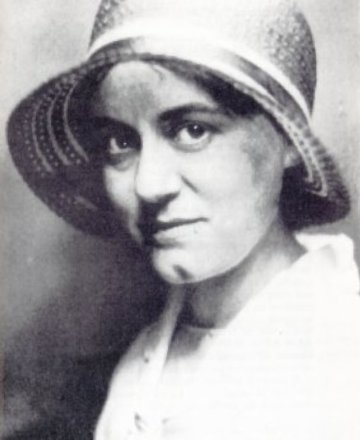
The 20th witnessed great advances in science and medicine. But it was not an era for truth. Research uncovered remarkable facts about the physical world, but philosophers and even average people were gripped by the idea that we cannot know anything for certain. Today, many — especially the most educated — allow that we all have notions of true and false, right and wrong, but that no one can claim anything is really the truth.
It is a hopeful sign, then, is that one 20th-century martyr made an extraordinary journey through modern uncertainties, and not only embraced, but was willing to die for the truth of the Catholic Faith.
Edith Stein was born to a well-off Jewish family in Breslau, Germany. Her father died when she was very young, and her mother was a very devout Jew and powerful woman. Edith early showed exceptional intelligence and, when few women pursued higher education, enrolled at the university. Along the way, she had lost her childhood Jewish faith, but her studies were to lead her to quite an unexpected rediscovery of God. [Continue]
Edith Stein — Convert, Nun, Martyr
Edith Stein is one of those people whose entire life seems to be a sign. She was born on Yom Kippur, the Jewish Day of Atonement, in 1891 in Breslau, Germany (now Wroclaw, Poland), the youngest of eleven children in a devout Jewish family.
When she was not yet two years old her father died suddenly, leaving Edith’s mother to raise the seven remaining children (four had died in childhood) and to manage the family business. Brought up on the Psalms and Proverbs, Stein considered her mother a living example of the strong woman of Proverbs 31, who rises early to care for her family and trade in the marketplace. By her teenage years, Stein no longer practiced her Jewish faith and considered herself an atheist, but she continued to admire her mother’s attitude of total openness toward God. [Continue]
More:
Carmelite Saints – The Life of Edith Stein
Edith Stein: A Brilliant Scholar Called to Share in Both the Virtue and Martyrdom of Christ
Women for Faith and Family – Saint Edith Stein (includes collect prayer, reading, and homily from canonization by John Paul II)
Association of Hebrew Catholics
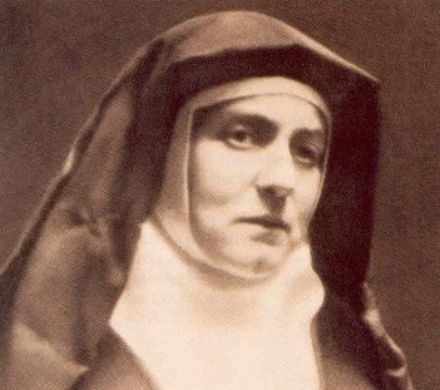
The Church in China
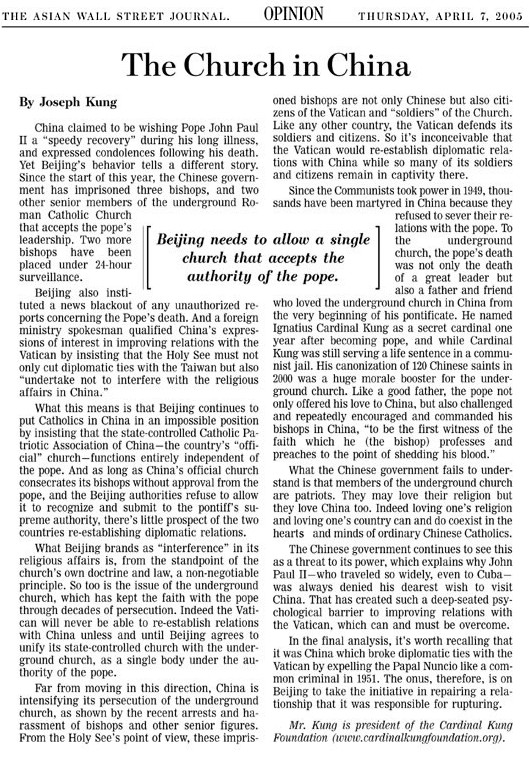
C.f. the Cardinal Kung Foundation.
St. Vincent Ferrer
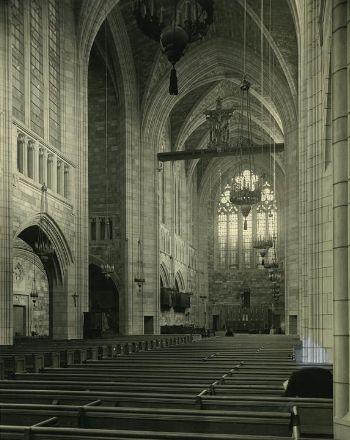
This photo shows the interior of the Dominican Church of St. Vincent Ferrer, designed by Goodhue, before it was fully completed. The stained glass has yet to be installed, and the same goes for the giant reredos which now graces the altar. A more current view is below.
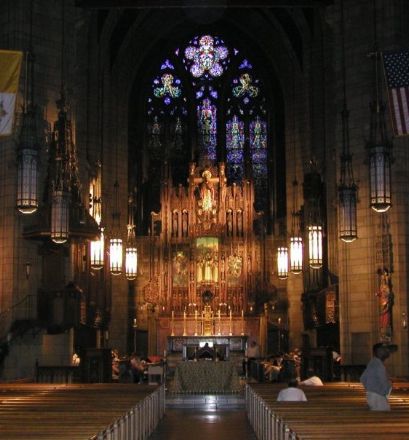
Church of Christ the King, Gordon Square, London
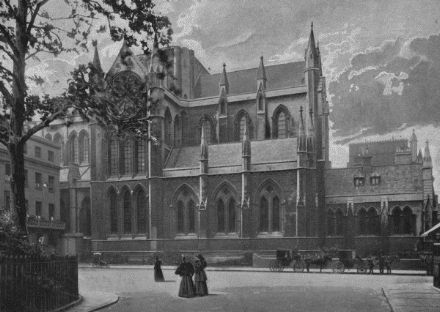
Though a comparitively small and minor sect, assiduous tithing by the members of Catholic Apostolic Church gave that group a number of stunning churches. (Their former church in Edinburgh was the subject of a previous posting).
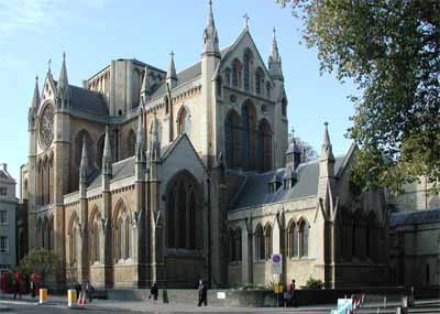
The building currently known as the Church of Christ the King on Gordon Square in Bloomsbury was constructed by the anachronistically-monikered Irvingites from 1853. The superb structure, built from Bath stone, is incomplete, lacking a few bays on the liturgical west of the building which kept the planned façade from being built. It also lacks a crossing tower, but then so does Westminster Abbey, the nave of which is only thirteen feet higher than that of Christ the King. (more…)
Canon Bernard Iddings Bell
Warden of St. Stephen’s College in the Hudson Valley of New York
As for what the Church thinks and says, what influence does that have on the handling of American politics, the conduct of American education, the regulation of marriage and divorce, on sex and drink, on how industrial disputes are settled, on how we carry on business?
As a plain matter of fact, religion in this country is generally regarded as a tolerated pastime for such people as happen to like to indulge in occasional godly exercises — as a strictly private matter in an increasingly close-knit and socially acting society — in other words, as something that does not count.
I should like to see the Church recognize that it has been pushed into the realm of the non-essentials, and to persuade it to fight like fury for the right and the duty to bring every act of America and Americans before the bar of God’s judgment.
[Christian leaders] are making valiant claim to such a right and duty; but the great mass of Church members are content to regard the Church as a conglomerate of private culture clubs, nice for christenings, weddings and funerals. Most Church members readily agree with the unchurched majority that it is not the proper business of the Church to criticize America or Americans.
— Canon Bernard Iddings Bell
The 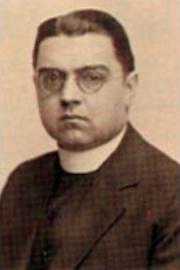 Rev. Canon Bernard Iddings Bell and seems to have been something all too rare in the history of America: a wise and presient Episcopalian cleric (which is not to say we have had any more than a mere handful of wise and presient Catholic clerics in this land).
Rev. Canon Bernard Iddings Bell and seems to have been something all too rare in the history of America: a wise and presient Episcopalian cleric (which is not to say we have had any more than a mere handful of wise and presient Catholic clerics in this land).
Bell served as Warden of St. Stephen’s College – situated on the Hudson River here in New York – from 1919 to 1933, and is widely considered responsible for turning it into what was one of the best collegiate institutions in the country. In 1928, under Bell’s tenure, St. Stephen’s became a college of Columbia University, and this period of the College’s history was highly praised by the great Russell Kirk.
Kirk, in Decadence and Renewal in the Higher Learning, after positing his view of the ideal undergraduate college as a place of classical and liberal learning, takes note of St. Stephen’s. “There have been such colleges in this country,” Kirk wrote. “One such was St. Stephen’s College… when Dr. Bernard Iddings Bell was president. (He told me once that he gave up the presidency when strong objection was raised to his rule that the students should dress decently and rise when professors entered a room.)”
Of course, such arcadian days did not last. Only a year after Bell gave up the wardenship of St. Stephen’s in 1933, the college changed its name from honoring Saint Stephen, the first Christian martyr, to the more secular Bard College honoring the founder of the institution, John Bard.
A mere ten years later in 1944, Bard College became coeducational and as such severed its relationship with Columbia University, becoming independent as a secular, nonsectarian liberal arts college ‘affiliated’ with the Episcopal Church. The once-great college has now declined to such an extent that a professorship there is now named in honor of Alger Hiss, the man who betrayed America to spy for Soviet Russia. Sic transit gloria mundi.
Kirk relates another anecdote of Dr. Bell:
Canon Bernard Iddings Bell once showed a visitor from England about the environs of Chicago. They drove past a handsome Gothic building of stone. “Is that a school?” inquired the visitor.
“Yes– a new one, ‘distressed’ to appear old,” Dr. Bell replied.
“Indeed! Who is the headmaster?”
“There is no headmaster.”
“Curious! A kind of soviet of teachers, I suppose.”
“There are no masters at all.”
“Really? Do the boys teach one another?”
“As yet, there are no students. Here in the United States, we proceed educationally in a way to which you are unaccustomed,” Canon Bell told his friend. “First we erect a building; then we obtain pupils; next we recruit teachers’ then we find a headmaster; and at last we determine what is to be taught. You begin at the other end in England.”
Again, a quote from Canon Bell:
We need to forget the imaginary Christ who has been ours too long and to rediscover the real Christ, the Christ of the prophets and the martyrs and the confessors, the Christ who is not only the lover of souls but also master, a monarch with demands to make in industry, in finance, in education, in the arts, in marriage, in the home; the Christ who is teacher of a social ideology which has eternal validity; the Christ who cries aloud with convincing force, ‘He who would save his life will lose it; only he who is willing to lose his life, can find it.’
Downside
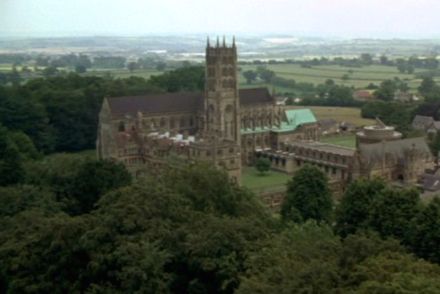
Last night I saw The Hole, a somewhat amusing ‘psychological thriller’ about a bunch of boarding school kids who lock themselves in an old bunker, have a party, then realise they can’t get out, yadda yadda yadda, people die. It was fairly light and worth watching if you’re easily entertained (and I often am). Perhaps the most enjoyable part was a few aerial shots of the Basilica of Saint Gregory the Great, Downside Abbey and School where our own Robert O’Brien will be teaching in the autumn. (The school was given a different name in the film).
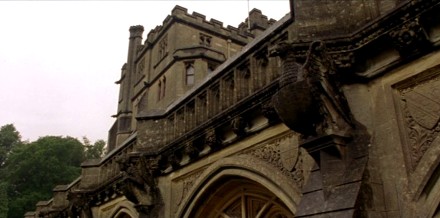
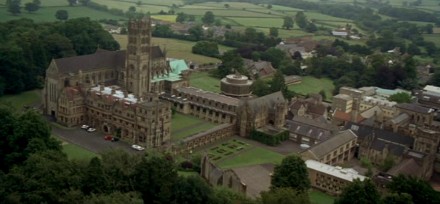
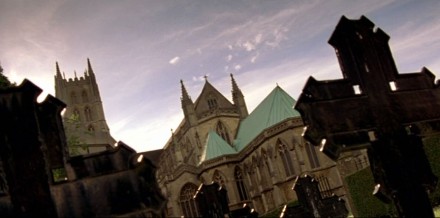
Chesterton Remembered
SIR: Your article on G.K. (This England, Summer 1986) brought back a happy personal memory of that great and kindly man. It was 1930 in Rome, where I was a pupil at a “finishing school” – in this case an English convent. G.K. sometimes came to visit our Reverend Mother; we knew him by sight and, once seen, who could forget the huge man in the big black cloak?
Part of our “finishing” process was to be taken round the museums and galleries of the Eternal City. One day we were being shepherded through the Vatican Museum. My friend and I somehow managed to get separated from the rest of our party and in one of the galleries whom should we see but Mr. G.K. Chesterton. He was about to leave so we followed him down the stairs in the hope of being able to get his autograph. At the foot of the stairs he turned. “As we had such young legs”, he said, “could one of us be so kind as to run back to the gallery where he had left his cloak, and would the other see if she could find him a carrozza [a cab, lit. ‘carriage’]?” We needed no second bidding. I raced back up the stairs, found the familiar black cloak where he had left it and triumphantly returned it to its owner. Meanwhile my friend had found a vacant carrozza. G.K. thanked us both, climbed into the carrozza and drove off. In the excitement we had forgotten about the autographs! Next day a letter arrived at our convent. He addressed it to “The Young Ladies suffering education at the convent at No. 10 Via Boncompagni.” Inside was a sheet full of auto-graphs and a little poem.
For you alone did I desire,
Who brought the prophet’s mantle down
And called his chariot of fire!
I have the precious autograph still and what a strange Chinese-looking affair it is!
— MRS. L. RIPLEY, BRIGHTON
Chartres 2005
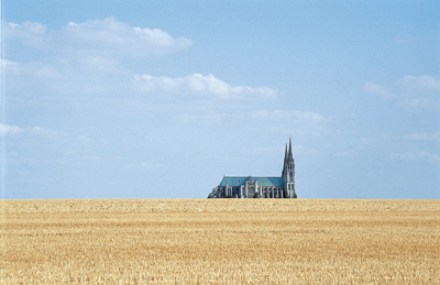
Various sites have put up photos from this year’s annual traditionalist Pentecost pilgrimage to Chartres, and I thought, as I did last year, I would gather a few of them and present them to you. (more…)
Risen from the Ashes
by Austin Ruse
Sursum Corda, Summer 1998
The first wholly traditional Catholic parish structure built since Vatican II could not be situated in a more central location, at a more opportune time. New York is enjoying an astounding 1990s rejuvenation, bulging with tourists and new business. St. Agnes Church is at the center of it all, in midtown Manhattan, near Grand Central Station.
 Only at St. Agnes in New York City can an orthodox churchman be attacked from the right. Yet there they were, a dedicated band of angry young people picketing Msgr. Eugene V. Clark at Mass only one week after St. Agnes had burned nearly to the ground in late 1992. Their charge? That the good Monsignor intended to replace the old brick Gothic structure, now ruined, with what they called a “Swedish-Igloo-Modern.” Monsignor Clark never gets mad, but he got mad that day – although today he looks back on the incident with amusement. He even saved one of their flyers and is considering having it framed.
Only at St. Agnes in New York City can an orthodox churchman be attacked from the right. Yet there they were, a dedicated band of angry young people picketing Msgr. Eugene V. Clark at Mass only one week after St. Agnes had burned nearly to the ground in late 1992. Their charge? That the good Monsignor intended to replace the old brick Gothic structure, now ruined, with what they called a “Swedish-Igloo-Modern.” Monsignor Clark never gets mad, but he got mad that day – although today he looks back on the incident with amusement. He even saved one of their flyers and is considering having it framed.
Did those excitable young men and women actually live within the parish boundaries of St. Agnes? No. But then hardly anybody actually lives in the East 40s. St. Agnes has maybe 100 to 150 residential parishioners. Nobody really cares, either; and this is one of the charms of St. Agnes. It is a commuter church located next to one of the busiest ports of call in the world, Grand Central Station. St. Agnes Church is a place that is searched out, discovered, chosen. To many it seems that St. Agnes chooses them.
But there was that awful day when many thought it might close. (more…)
His Holiness and His Most Eminent Highness
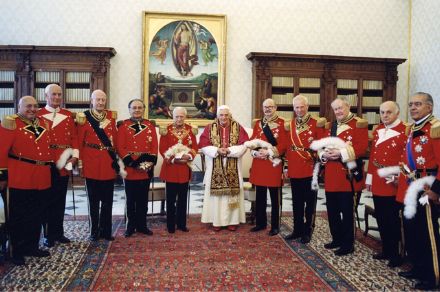
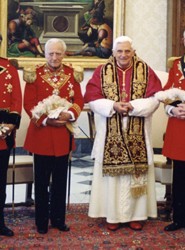 By special request, I bring you photos of the recent audience of His Holiness Benedict XVI, Bishop of Rome, Vicar of Jesus Christ, Successor of the Prince of the Apostles, Supreme Pontiff of the Universal Church, Patriarch of the West, Primate of Italy, Archbishop and Metropolitan of the Roman Province, Sovereign of the State of the Vatican City, Servant of the Servants of God (to use his full title) with His Most Eminent Highness, Fra’ Andrew Willoughby Ninian Bertie, Prince and Grand Master of the Sovereign Military and Hospitaller Order of St. John of Jerusalem, of Rhodes, and of Malta, Most Humble Guardian of the Poor of Jesus Christ (likewise, to use his full title) along with the Sovereign Council of the said order. According to ecclesiastical protocol the Grand Master, though merely a vowed religious, is accorded a dignity equal to that of a cardinal. His Holiness received the Grand Master and Sovereign Council on June 24, 2005, the Feast of St. John the Baptist, who is the patron saint of the Order. The Grand Master was also greeted on April 24 of this year, when the photograph below was taken.
By special request, I bring you photos of the recent audience of His Holiness Benedict XVI, Bishop of Rome, Vicar of Jesus Christ, Successor of the Prince of the Apostles, Supreme Pontiff of the Universal Church, Patriarch of the West, Primate of Italy, Archbishop and Metropolitan of the Roman Province, Sovereign of the State of the Vatican City, Servant of the Servants of God (to use his full title) with His Most Eminent Highness, Fra’ Andrew Willoughby Ninian Bertie, Prince and Grand Master of the Sovereign Military and Hospitaller Order of St. John of Jerusalem, of Rhodes, and of Malta, Most Humble Guardian of the Poor of Jesus Christ (likewise, to use his full title) along with the Sovereign Council of the said order. According to ecclesiastical protocol the Grand Master, though merely a vowed religious, is accorded a dignity equal to that of a cardinal. His Holiness received the Grand Master and Sovereign Council on June 24, 2005, the Feast of St. John the Baptist, who is the patron saint of the Order. The Grand Master was also greeted on April 24 of this year, when the photograph below was taken.
If we have any more Order-of-Malta-related posts, a whole category will have to be devoted to them!
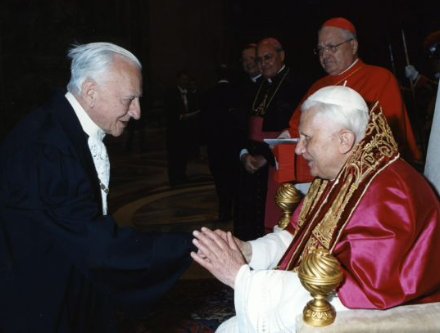
St. Gregory’s, Brooklyn
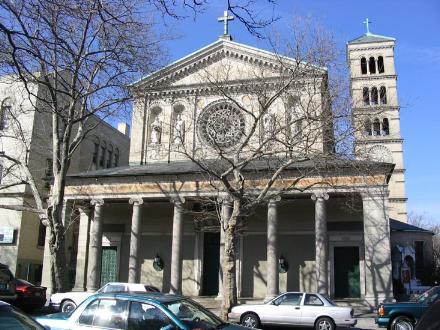
“St. Gregory’s Church of 1917, located at Brooklyn Avenue and St. John’s Place, was closely based on the ‘idealistic ground plan’ of St. Clement in Rome, an archetypal basilica with an open, colonnaded narthex and a tall engaged campanile on one side of the nave. In keeping with its prototype, St. Gregory’s was gaudily decorated with figural frescoes and mosaics.” – New York 1930
It seems a rather pulchritudinous church; I’ll have to add it to the list of places to visit. It was designed by Helmle and Corbett, who were also responsible for the Bush Tower, built a year later. The Bush Tower will soon get a brand new neighbor, seen below.

Top photo lifted from the ever-nifty Bridge and Tunnel Club‘s Walk Down Brooklyn Avenue.
Home Again
A pleasantly uninteresting flight across the realm of the Atlantic and I am happy to find myself home in New York once more. Not much sooner had my parents and I returned to our little abode in Eastchester than we were off to dinner courtesy of Uncle Matt and Aunt Naomi (who live next door to us) at a happy little place called Joe’s on Marbledale Road in Tuckahoe — an eatery quite keen on what is most often called home food: simple, filling, and particularly appropriate in this circumstance. I then had my first legal drink in the States: Brooklyn IPA (India Pale Ale). Not a poor drink, but didn’t strike my fancy terribly. I have had better pints before, legal or not.
After we all returned to the Cusack family compound, I tried to convince my mother of the efficacy of Catholic social teaching for a bit before heading into town to Roger Mahon’s house, wherein lay Michelle Carroll and good ole Will Freeman. Mikey, the Mahons’ Irish Wolfhound, is pretty much fully grown now, but of a very kind nature. Caro Gill should’ve been there but was exhausted since it was her birthday.
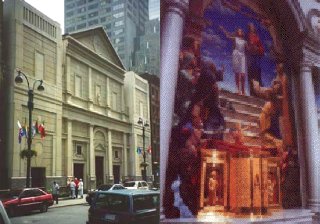
The Church of St. Agnes: exterior and tabernacle.
As I have often said, I always really know I’m home when I’ve heard the intoxicating incantation of the Asperges me at the 11:00 at St Agnes. The train from Bronxville is scheduled to arrive in Grand Central at 11:04 but almost always gets in two minutes before the hour, allowing just enough time to ascend to the grand concourse of that beaux-arts temple of transit, scurry through the Graybar passage, hop across Lexington Avenue to arrive at St Agnes just as the procession is finished and the Asperges commences. Today proceeded right on target.
Asperges me Domine hyssopo et mundabor,
lavabis me et super nivem dealbabor.
Misere mei, Deus, secundum magnam misericordiam tuam.
Gloria patri et filio et spiritui sancti,
erat in principio et nunc et semper et in saecula seculorum. Amen.
Asperges me Domine hyssopo et mundabor,
lavabis me et super nivem dealbabor.
The wonderful thing about the Latin mass at St Agnes is it’s always just as it should be. It’s not an over-the-top ostentatious drama as you might find at Anglo-catholic churches, nor a wailing maelstrom as at some charismatic churches, nor a banal mediocrity as at the average Marty Haugen parish. It is what it is, and it is beautiful and reflective of God’s eternal glory.
Taking the train back to Bronxville, on Metro-North’s brand spanking new rolling stock I might add, I noticed a number of new buildings which popped up along the line since I last travelled on it in the winter; chiefly in Harlem. There were about five new structures: one was bland and inspid, but three were fairly decent attempts at good New York vernacular, and one was an exceptional example of the said style. It was brick, with proper windows, a wonderful cornice, and everything you might expect of a building of its kind built in the 1900’s or thereabouts. I don’t know how it managed to get built today, nor by whom, nor do I know what it is (looked like housing), but it was most certainly a new building and I admire whoever’s behind it for making new New York architecture in the New York style. Bravo.
Now I must be off to cocktails next door at the Colonel’s. It’s good to be home.
The Cardinal Visits St Andrews
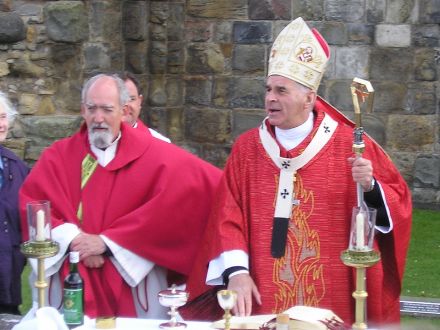
His Eminence, Keith Patrick O’Brien, the Cardinal Archbishop of St Andrews & Edinburgh visited St Andrews today, and offered the holy sacrifice of the Mass in the ruins of the Cathedral. It was the first time the Cardinal was in St Andrews since receiving his honorary degree last June. Above are Canon Halloran, our parish priest and Catholic chaplain to the University, and His Eminence.
It was unusually cold today and the ruins of the Cathedral were windswept, but we held fast and stayed for the whole mass. (There were about fifty or so in attendance). His Eminence even gave the final blessing and dismissal in Latin, after which he lead us in facing east and chanting the Salve Regina. Then we were all off to the parish hall for some tea, coffee, and cake. (more…)
Burke to Rome!
This morning after the 9:00am Mass we learned that Fr. Patrick Burke has been summoned to the Eternal City for a job at the Congregation of the Doctrine of the Faith. Fr. Burke, who was Convener of the University of St Andrews Union Debating Society (f. 1794) and President of the Catholic Society during his undergraduate days, is just about the best (diocesan) priest in Scotland.
Oft-described as a Rhodesian-born English priest of a Scottish diocese who’s spent more time in Italy than anywhere else and speaks German to boot, Fr. Burke has a massive following at his alma mater. He is currently a parish priest in Stirling and Bannockburn as well as editor of Faith magazine. We were all elated to hear of his appointment, though the precise details of it are unknown at the moment, though we are saddened that it means he will likely be unavailable for his popular, informative, and hilarious talks at Canmore anymore.
A brilliant academic with excellent pastoral skills as well; not a common combination. We wish him all the best.
The Holy Father’s Installation

Deo gratias!
Search
Instagram: @andcusack
Click here for my Instagram photos.Most Recent Posts
- Faithful Shepherd of the Falklands April 8, 2025
- Articles of Note: 8 April 2025 April 8, 2025
- Proportionality Destroys Representation April 8, 2025
- Sag Harbor Cinema March 26, 2025
- Teutonic Takeover March 10, 2025
Most Recent Comments
Book Wishlist
Monthly Archives
Categories

